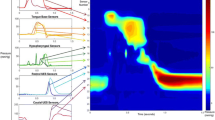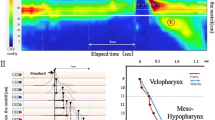Abstract
A unified discussion of the mechanics of the swallowing process, and its interpretation through manometric measurements of intraluminal pressure, are presented in this paper. The goals of the discussions are to provide the reader with basic knowledge of pharyngeal, esophageal, and sphincter mechanics; to relate the mechanical processes to intraluminal pressure recordings; and to clarify the relationship between intraluminal pressure and esophageal muscle contractile behavior. The esophageal phase of bolus transport, in particular, is discussed in some detail due to the relatively simple geometry and the straightforward description of peristalsis and muscle mechanics in this region. Several important issues are emphasized in the discussion. For example, pressure variation within a static bolus is fundamentally different from that within a moving bolus. Manometric recordings must be interpreted accordingly. The importance of differentiating between “hydrodynamic pressure,” which is pressure measured within a fluid bolus, and “contact pressure,” which is the direct squeeze of the luminal wall on the manometric port in a region devoid of bolus fluid, is discussed in some detail. We argue that pressure “amplitude” does not, in principle, give any indication of the forces required to drive the fluid bolus forward. What should be sought is the variation of intrabolus pressure relative to the contact pressure, particularly during periods in which the contractile segment fails to obliterate the esophageal lumen. Examples of intraluminal pressure recording in the esophagus, using manometry and mathematical models, are presented to demonstrate both the possibilities and the difficulties of interpreting manometric recordings in the absence of concurrent radiographic imaging. We discover that in regions of nearly complete luminal closure, the pressure signature and bolus geometry are strongly coupled during peristaltic transport, providing the possibility that in these regions quantitative measures of muscle performance might be developed without the need for radiographic imaging. On the other hand, the ambiguity in the interpretation of manometric recordings that often accompanies dysphagic conditions suggests that as more sophisticated interpretations are sought, manometry concurrent with radiography will play a more prominent role in patient evaluation.
Similar content being viewed by others
References
Jones B, Ravich WJ, Donner MW, Kramer SS, Hendrix TR: Pharyngoesophageal interrelationships: observations and working concepts.Gastrointest Radiol 10: 225–233, 1985
Dodds WJ: Current concepts of esophageal motor function: clinical implications for radiology.J Roetgenol 128: 549–561, 1977
Brasseur JG: A fluid mechanical perspective on esophageal bolus transport.Dysphagia 2: 32–39, 1987
Li MJ, Brasseur JG, Kern MK, Dodds WJ: Viscosity measurements of barium-sulfate mixtures for use in motility studies of the pharynx and esophagus.Dysphagia, 1992 (in press)
Dantas RO, Kern MK, Massey BT, Dodds WJ, Kahrilas MD, Brasseur JG: Effect of swallowed bolus variables on the oral and pharyngeal phases of swallowing.Am J Physiol 258: G675-G681, 1990
Brasseur JG, Dodds WJ, Massey BT, Kern MK, Helm JF, Kahrilas, PJ: Esophageal pressure during peristaltic transport of a fluid bolus: distinction between intrabolus and contractile-segment pressure domains (abstr).Gastroenterology 96: 56, 1989
Kahrilas PJ, Dent J, Dodds WJ, Hogan WJ, Arndorfer RC: A method for continuous monitoring of the upper esophageal sphincter pressure.Dig Dis Sci 32: 121–128, 1987
Winans CS: The pharyngoesophageal closure mechanism: a manometric study.Gastroenterology 63: 768–777, 1972
Welch RW, Luckmann K, Ricks PM, Drake ST, Gates GA: Manometry of the normal upper esophageal sphincter and its alteration in laryngectomy.J Clin Invest 63: 1036–1041, 1979
Dodds WJ, Stef WJ, Hogan SE, Hoke SE, Stewart ET, Arndorfer RC: Radial distribution of esophageal peristaltic pressure in normal subjects and patients with esophageal diverticulum.Gastroenterology 69: 584–590, 1975
Roos R, Lykoudis PS: The fluid mechanics of the ureter with an inserted catheter.J Fluid Mech 46: 625–630, 1971
Lydon SB, Dodds WJ, Hogan WJ, Arndorfer AS: The effect of manometric assembly diameter on intraluminal esophageal pressure.Am J Dig Dis 20: 968–970, 1975
Dodds WJ, Stef WJ, Hogan SE: Factors determining pressure measurement accuracy by intraluminal esophageal manometry.Gastroenterology 70: 117–123, 1976
Tøttrup A, Forman A, Uldbjerg N, Funch-Jenson P, Anderson K-E: Mechanical properties of isolated human esophageal smooth muscle.Am J Physiol 258: G338-G343, 1990
Biancani P, Zabinski MP, Behar J: Pressure, tension, and force of closure of the human lower esophageal sphincter and esophagus.J Clin Invest 56: 476–483, 1975
Dodds WJ, Kahrilas PJ, Dent J, Hogan WJ: Considerations about pharyngeal manometry.Dysphagia 1: 209–214, 1987
Arndorfer RC, Stef JJ, Dodds WJ, Lineham JH, Hogan WJ: Improved infusion system for intraluminal esophageal manometry.Gastroenterology 73: 23–27, 1977
Massey BT, Dodds WJ, Helm JF, Brasseur JG, Hogan WJ: Abnormal esophageal motility: comparison of radiographic and manometric findings (abstr).Gastroenterology 95: 878, 1988
Chen YM, Ott DJ, Hewson EG, Richter JE, Wu WC, Gelfand DW, Castell DO: Diffuse esophageal spasm: radiographic and manometric correlation.Radiology 170: 807–810, 1989
Ott DJ, Richter JE, Chen YM, Wu WC, Gelfand DW, Castell DO: Esophageal radiography and manometry: correlation in 172 patients with dysphagia.AJR 149: 307–311, 1978
Vantrappen G, Janssens J, Hellemans J, Coremans G: Achalasia, diffuse esophageal spasm, and related motility disorders.Gastroenterology 76: 450–457, 1979
Sanderson DR, Ellis FH, Schlegel JF, Olsen AM: Syndrome of vigorous achalasia: clinical and physiologic observations.Dis Chest 52: 508–517, 1967
Sleisenger MH, Fordtran JS:Gastrointestinal Disease. Philadelphia: WB Saunders, 1973 (1st ed), 1983 (3rd ed)
Ren J, Dodds WJ, Martin CJ, Dantas RO, Mittal R, Kern MS, Brasseur JG: Effect of increased intraabdominal pressure on peristalsis in the feline esophagus (abstr).Gastroenterology 99: 1228, 1990
Kahrilas PJ, Dodds WJ, Hogan WJ: Effect of peristaltic dysfunction on esophageal volume clearance.Gastroenterology, 94: 73–80, 1988
Cook IJ, Dodds WJ, Dantas RO, Massey B, Kern MK, Lang IM, Brasseur JG, Hogan WJ: Opening mechanism of the upper esophageal sphincter.Am. J. Physiol. 257: G748-G759, 1989
Cerenko D, McConnel FMS, Jackson RT: Quantitative assessment of pharyngeal bolus driving forces.Otolaryngol Head Neck Surg 100: 57–63, 1989
Jones B, Kramer SS, Donner MW: Dynamic imaging of the pharynx.Gastrointest Radiol 10: 213–224, 1985
Bosma JF, Donner MW, Tanaka E, Robertson D: Anatomy of the pharynx, pertinent to swallowing.Dysphagia 1: 23–33, 1986
Jacob P, Kahrilas PJ, Logemann JA, Shah V, Ha T: Upper esophageal sphincter opening and modulation during swallowing.Gastroenterology 97: 1469–1478, 1989
Brasseur JG, Corrsin S, Lu NQ: The influence of a peripheral layer of different viscosity on peristaltic pumping with Newtonian fluids.J Fluid Mech 174: 495–519, 1987
Li M-J, Brasseur JG, Dodds WJ: Nonsteady model of peristaltic transport applied to swallowing (abstr). Proceedings 16th Annual N.E. Bioengineering Conference IEEE No. 90-CH 28340, 58–59
Li M-J, Brasseur JG, Dodds WJ: Analyses of normal and abnormal esophageal bolus transport using computer simulations. In preparation.
Author information
Authors and Affiliations
Rights and permissions
About this article
Cite this article
Brasseur, J.G., Dodds, W.J. Interpretation of intraluminal manometric measurements in terms of swallowing mechanics. Dysphagia 6, 100–119 (1991). https://doi.org/10.1007/BF02493487
Issue Date:
DOI: https://doi.org/10.1007/BF02493487




